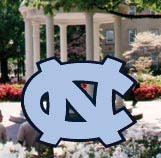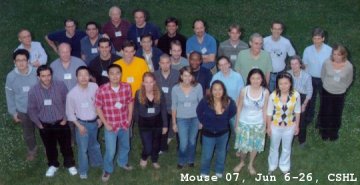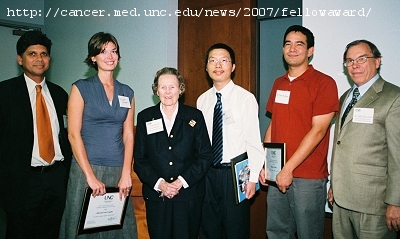On 12-13-2007, I passed my dissertation defense!
 I was so lucky that I got the offer from UNC to start my graduate study
I was so lucky that I got the offer from UNC to start my graduate study
I was so lucky that Vytas just finished the renovation of the department
I was so lucky that I could have my graduate study under Jim's advising
I was so lucky that I could attend the training course about mouse embryo manipulation in Cold Spring Harbor
......
There were many kind and honorable people helped me and encouraged me while I was in Chapel Hill. I want to say from my heart "THANK YOU".
I am proud that I am Tar Heelized.
 From Aug 2003 to Dec 2007, I had a smooth, fruitful graduate study in the University of North Carolina at Chapel Hill,
which is the oldest public university chartered in 1789.
I spent many nights before the bench. It was a mixture of sad/exciting feeling.
I really enjoy the life of doing research. I decide I will continue my academic journey.
From Aug 2003 to Dec 2007, I had a smooth, fruitful graduate study in the University of North Carolina at Chapel Hill,
which is the oldest public university chartered in 1789.
I spent many nights before the bench. It was a mixture of sad/exciting feeling.
I really enjoy the life of doing research. I decide I will continue my academic journey.
Here is part of my dissertation "CORONIN 1B COORDINATES ACTIN DYNAMICS IN LAMELLIPODIA". Full version is available from ProQuest Dissertation Express service. In the middle of 2009, I wrote a 1000-word essay summarizing my thesis, which you might be interested to have a look.
Publication
» Liang CAI, Alexander M Makhov, Dorothy A Schafer and James E Bear. Coronin 1B antagonizes Cortactin and remodels Arp2/3-containing actin branches in lamellipodia.
Cell [J], 2008, 134(5):828-842.
[The-Cover, Listed, Recommended in F1000, Featured by Cell Migration Gateway; PMID 18775315]
» Liang CAI and James E Bear. Peering deeply inside the branch.
Journal of Cell Biology [J], 2008, 180(5):853-855.
[comment on Rouiller et al. 2008; PMID 18316414]
» Liang CAI, Alexander M Makhov, and James E Bear. F-actin binding is essential for coronin 1B function in vivo.
Journal of Cell Science [J], 2007, 120(10):1779-1790.
[The-Cover, Listed; PMID 17456547]
» Liang CAI, Thomas W Marshall, Andrea C Uetrecht, Dorothy A Schafer, James E Bear. Coronin 1B coordinates Arp2/3 complex and Cofilin activities at the leading edge.
Cell [J], 2007, 128(5):915-929.
[Listed, Highlighted in Nature, Recommended in F1000; PMID 17350576]
» Thomas W Marshall, Liang CAI, James E Bear. Chemistry comes to the cell: ASCB 2005.
Nature Chemical Biology [J], 2006, 2(3):119-122.
[PMID 16484998]
» Liang CAI, Nicholas Holoweckyj, Michael D Schaller, James E Bear. Phosphorylation of coronin 1B by protein kinase C regulates interaction with Arp2/3 and cell motility.
The Journal of Biological Chemistry [J], 2005, 280(36): 31913-31923.
[PMID 16027158]
Honors Received in Graduate School
|
» 2007 Chinese Government Award for Outstanding Students Abroad |
Meeting Abstracts
» Coronin 1B Debranches Actin Filaments Generated by the Arp2/3 Complex
L. Cai,1,2 A. M. Makhov,3 D. A. Schafer,4 J. E. Bear1,2;
1Department of Cell and Developmental Biology, UNC-Chapel Hill, Chapel Hill, NC,
2Lineberger Comprehensive Cancer Center, Chapel Hill, NC,
3Department of Microbiology and Immunology, University of North Carolina at Chapel Hill, Chapel Hill, NC,
4Department of Biology and Cell Biology, University of Virginia, Charlottesville, VA
Presentation Number: 1014-ASCB2007 (not show up due to conflict with my thesis defense schedule)
Actin cytoskeleton assembly and remodeling are complex processes that require precise spatial and temporal control of actin and numerous actin-binding proteins. Coronins are highly conserved actin binding proteins that have been implicated in numerous cellular processes such as chemotaxis and fibroblast motility. In lamellipodia, current experimental evidence suggests that Coronin 1B coordinates Arp2/3 complex and Cofilin activities and plays a critical role in regulating actin dynamics. Despite the strong phenotypes observed upon Coronin 1B depletion in vivo, recombinant Coronin 1B exhibits modest inhibition of Arp2/3 nucleation in pyrene actin assays. To elucidate the molecular mechanism of Coronin 1B’s inhibition on Arp2/3 complex activity, we utilized TIRF microscopy to study Arp2/3-mediated actin branch formation in real time. Using this technique, we observed much slower total actin filament growth and much higher frequency of de-branching events in the presence of Coronin 1B than in controls. We developed an in vitro biochemical assay to analyze Coronin 1B’s effect on de-branching. Wild-type Coronin 1B not only de-branches Arp2/3 actin filaments, but also disrupts the interaction between the Arp2/3 complex and the sides of actin filaments (IC50, 73 nM). Using specific Coronin 1B mutants, we observed that both F-actin and Arp2/3 binding activity are required for this effect. Interestingly, we found that Cortactin enhances Arp2/3's side-binding (IC50, 51 nM) in this assay. Consistent with previous data, we observed that Cortactin stabilizes the actin branches in TIRF analysis. Finally, we found that Coronin 1B antagonizes Cortactin in pyrene-actin assays. These data demonstrate that Coronin 1B is the first known protein with specific Arp2/3 de-branching activity, and that Coronin 1B is a direct antagonist of Cortactin in actin dynamics.
» Coronin 1B Coordinates Arp2/3 and Cofilin Activity at the Leading Edge
J. E. Bear,1 L. Cai,1 T. W. Marshall,1 A. C. Uetrecht,1 D. A. Schafer2;
1Cell & Developmental Biology, UNC-Chapel Hill, Chapel Hill, NC,
2Biology, University of Virginia, Charlottesville, VA
Presentation Number: 722-ASCB2006
Talk: Minisymposium 14 - Regulation of the Cytoskeleton
Arp2/3-dependent actin filament nucleation and Cofilin-driven filament turnover are
two major factors that control the dynamics of lamellipodia in motile cells, but the coordination of these activities is
poorly understood. Coronins are highly conserved F-actin binding, WD repeat proteins that have been implicated in cell
motility in model organisms. Yeast Coronin inhibits Arp2/3 complex in vitro, but the function of Coronins in mammalian
cells is not known. We report that human Coronin 1B inhibits actin nucleation by the Arp2/3 complex and that this
inhibition is regulated by the Slingshot-1L (SSH1L) phosphatase via the dephosphorylation of Serine 2 on Coronin 1B.
Furthermore, we find that SSH1L, Coronin 1B and Arp2/3 exist in a ternary complex in vivo that is bridged by Coronin 1B.
Functional studies of lamellipodial dynamics indicate that depletion of Coronin 1B alters lamellipodial protrusion and
that Coronin 1B is required for enhanced ruffling at the cell periphery induced by expression of SSH1L. In addition to
being a substrate for SSH1L, Coronin 1B is required for proper targeting of SSH1L to lamellipodia where it likely regulates
filament turnover by activating Cofilin. Consistent with this idea, depletion of Coronin 1B increased cellular levels of
phospho-Cofilin and expression of an activated Cofilin mutant partially suppressed the effects of Coronin 1B knockdown on
lamellipodia dynamics. Together, our data suggest that Coronin 1B coordinates Arp2/3 and Cofilin activity at the leading
edge.
» Serine 2 Phosphorylation Regulates Coronin 1B Activity and Affects Cell Migration
L. Cai,1,2 M. D. Schaller,1,2 J. E. Bear1,2;
1Cell and Developmental Biology, School of Medicine, UNC at Chapel Hill, Chapel Hill, NC,
2Lineberger Comprehensive Cancer Center, Chapel Hill, NC
Presentation Number: 2444-ASCB2005
Poster Board Number: B215-ASCB2005
Coronin 1B, a conserved WD40 repeat-containing, actin binding protein, is ubiquitously
expressed and co-localizes with the Arp2/3 complex at the leading edge of fibroblasts. Pharmacological experiments show
that the interaction between Coronin 1B and the Arp2/3 complex is regulated through protein kinase C (PKC) phosphorylation.
Using tryptic peptide mapping and site-direct mutagenesis, we show that Coronin 1B is phosphorylated at Serine 2 (Ser2)
upon phorbol-12-myristate-13-acetate (PMA) stimulation in vivo. Rat2 fibroblasts expressing the Coronin 1B S2A
mutant show enhanced ruffling in response to PMA and increased speed in single cell tracking assay, while the S2D mutant
expression attenuates PMA-induced ruffling and slows cell speed. Expression of the S2A mutant partially protects cells
from the inhibitory effects of PMA on cell speed. These data demonstrate that Coronin 1B regulates leading edge dynamics
and cell motility in fibroblasts through Ser2 phosphorylation, and this phosphorylation is responsible for a measurable
fraction of PMA's effects on motility. To elucidate the regulation of Coronin 1B function via Ser2 phosphorylation,
we developed an assay for measuring dephosphorylation using a phosphor-specific antibody. Following termination of PMA
treatment with PKC inhibitors, phosphorylated Coronin 1B undergoes a rapid, okadaic acid-insensitive dephosphorylation
and returns to basal phosphorylation level within 10 min. RNAi-mediated knockdown of Coronin 1B leads to defects in both
leading edge protrusion and cell motility, which can be rescued by over-expression extrinsic wild-type protein. While S2A
and S2D mutants reciprocally enhance or suppress cell motility in the presence of wild-type protein, neither is capable of
rescuing Coronin 1B knockdown phenotypes. These data are consistent with a model in which Coronin 1B undergoes cycles of
phosphorylation and dephosphorylation in vivo in order to function properly.
» Coronin 1B interacts with Arp2/3 and is regulated by PKC
L. Cai, N. Holoweckyj, M. D. Schaller, J. E. Bear;
Cell and Developmental Biology, Lineberger Cancer Center, School of Medicine, UNC at Chapel Hill, NC
Presentation Number: 1495-ASCB2004
Poster Board Number: B141-ASCB2004
Cancer metastasis, embryonic development, and many other processes rely on actin-based cell migration.
Coronins are a family of WD40 repeat-containing actin binding proteins first discovered in Dictyostelium.
Coronin 1B is a ubiquitously expressed member of the mammalian Coronin family that is localized to the leading
edge, actin stress fibers and endocytic structures in fibroblasts. Molecular modeling indicates that the WD
repeats of Coronin 1B adopt a beta barrel structure, but that conserved regions on either side of the five
canonical WD repeats each contribute an additional blade to the structure. This model strongly suggests that
Coronins have a seven bladed beta barrel structure, rather than the five-bladed model postulated by earlier
studies. Coronin 1B co-localizes with the Arp2/3 complex at the leading edge suggesting that these proteins
may co-operatively regulate cytoskeleton organization. Co-immunoprecipitation confirms the interaction between
Coronin 1B and Arp2/3. Previous work suggested that Coronins may be regulated by PKC phosphorylation.
Recombinant Coronin 1B is robustly phosphorylated by PKC alpha in vitro. Metabolic labeling of HEK293 cells
with radioactive orthophosphate shows that Coronin 1B is phosphorylated in response to PMA stimulation in vivo.
Using tryptic peptide mapping and mutagenesis, we have identified a single site on Coronin 1B that is
phosphorylated by PKC in vivo. Initial data indicate that PKC phosphorylation of Coronin 1B regulates its ability
to partition between a cytosolic pool and an actin-associated pool.
During my stay in UNC at Chapel Hill ...
» Jul 15 2008, Presentation in Dr. Griffith's lab meeting: Applications of electron microscopy in cytoskeleton research
» Mar 28 2008, Talk in 4th Developmental Biology Symposium: Coronin debranches actin filaments and its role in phago-lysosome maturation
» Dec 13 2007, Dissertation defense: Coronin 1B coordinates actin dynamics in lamellipodia
» Jan 19 2007, Departmental In-House presentation and 3rd committee meeting: Coronin and actin: F-actin binding mediated stable leading edge localization is essential for Coro1B function
» Mar 10 2006, Departmental In-House presentation and 2nd committee meeting: A Slingshot 1L and Coronin 1B complex at the leading edge
» Feb 22 2006, Presentation in Cell Motility Club: A Slingshot 1L and Coronin 1B complex at the leading edge of fibroblasts
» Jan 09 2006, Presentation in Dr. Schafer's lab meeting: Coronin 1B functions in leading edge dynamics
» Sep 09 2005, Dissertation proposal oral defense / 1st committee meeting: Role of Coronin 1B in Lamellipodia Dynamics
» Apr 01 2005, Departmental In-House presentation: Coronin 1B’s phosphorylation regulation and more
» Nov 12 2004, Presentation in Cytoskeleton Group Meeting: Dephosphorylated Coronin 1B Interacts with Arp2/3 Complex
» May 31 2004, Qualify exam: The Tetraspanin Web in Exosome Biogenesis [committee members: Andrew Morris, Peter Petrusz, Joe Costello]
» Apr 2004, Rotation 3rd: PKC-alpha phosphorylates cytoskeleton protein in vitro in Michael D. Schaller's Lab [Presentation in Departmental In House Seminar] [Audio Record]
» Feb 2004, Rotation 2nd: Roles of mammalian Coro1B in Actin Dynamics and Cell Migration in James E. Bear's Lab [Poster]
» Oct 2003, Rotation 1st: In Vitro EGFP-CALI Comprehensive Analysis in Kenneth A. Jacobson's Lab [Poster] [Presentation]
» Courses taken between 2003-2004 |
PHCO250 (Fall 2004) [1 2
3 4]
CBIO325 (Spring 2004) [1 2 3 4] CBIO324 (Fall 2003) [1 2 3 4 5 6 7] CBIO117 (Fall 2003) [1 2 3 4 5] |
